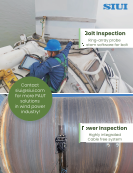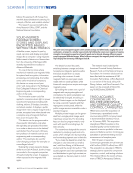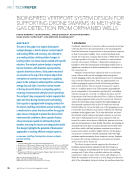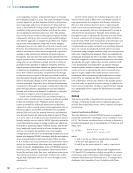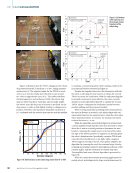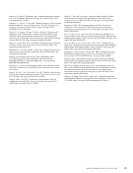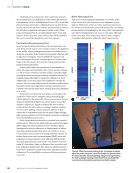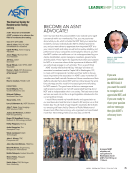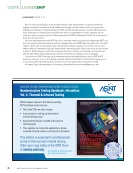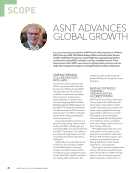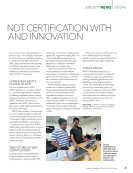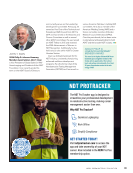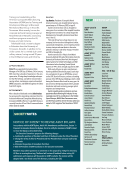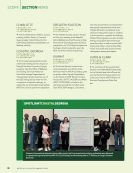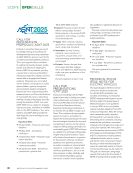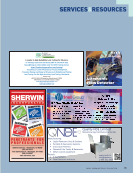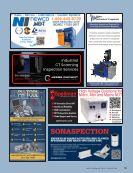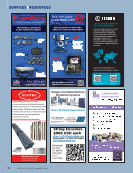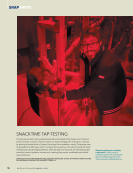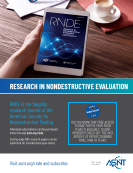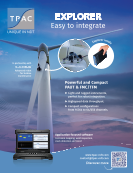BEYOND ROBOTICS, MATERIALS, AND
SENSING: UNVEILING BIOINSPIRATION IN
NONDESTRUCTIVE EVALUATION FROM
“NATURE’S NDE SPECIALISTS”
BY EHSAN DEHGHAN-NIRI
While bioinspiration research has led to advancements in fields such
as robotics, materials, sensing, and neural computation over the past
few decades, its application to more mission-oriented tasks, like
nondestructive testing/evaluation (NDT/E), remains largely unexplored.
Bioinspiration in NDT/E offers innovative approaches to advance current
technologies by drawing inspiration from natural systems that perform
similar tasks or processes. This paper explores three unique biological
systems—aye-ayes, termites, and red/arctic foxes—referred to as “nature’s
NDE specialists.” These organisms have evolved specialized food
foraging processes to detect, characterize, assess materials, and detect
targets in their environments without disruption, mirroring the goals of
NDT/E methods such as tap testing and leakage detection. By studying
these specialized processes, we can pioneer new NDT/E technologies or
advance the current ones, by means of enhancing reliability, sensitivity,
adaptability, and accessibility in challenging environments. Additionally,
integrating bioinspiration into NDT/E education can attract a new
generation of students, creating opportunities to address the workforce
challenges in the NDT/E field.
1. Introduction
Biological systems have evolved over
millions of years, exhibiting remarkable
adaptations that enhance survival in
diverse and sometimes harsh environ-
ments. Throughout this evolutionary
journey, these systems have developed
specialized capabilities that allow them
to thrive in various conditions, position-
ing them as a rich source of inspiration
to pioneer sophisticated tools, algo-
rithms, and machines [1]. Bioinspiration
involves understanding the principles
underlying the behavior, structure, and
sensory aspects of biological systems, and
applying these principles to the develop-
ment of engineering systems designed
to serve specific purposes, mirroring the
functions of the biological systems. The
key steps in transforming bioinspiration
into practical NDT/E technologies or
tools are outlined in Figure 1. These steps
can be utilized for the development of
robots, as well as advancements in mate-
rials, control systems, data processing
algorithms, and sensing technologies.
Among various mechanisms, three
aspects are particularly influential in the
development of new technologies:
Ñ sensing, sensory intelligence, and
neural computation,
Ñ materials and structures, and
Ñ mobility, control, and autonomy.
The first key aspect is the evolution
of advanced multifunctional sensing
systems and neural computation that
enable organisms to communicate,
forage for food, and evade predators.
Additionally, the development of unique
structural and morphological features,
along with the materials that constitute
their bodies, contributes to their excep-
tional adaptability. Finally, the actuation
and mobility mechanisms that allow
them to perform essential tasks further
highlight their success in the survival
journey. These remarkable traits make
biological systems a powerful source of
inspiration for innovating and engineer-
ing new technologies.
1.1. Sensing, Sensory Intelligence,
and Neural Computation
Since life first emerged on land hundreds
of millions of years ago, reliable infor-
mation has been essential for organ-
isms across all biological systems to
make reliable decisions critical for their
FEATURE
|
NDTTUTORIAL
Observation
Bioinspired
NDT/E
Concept
and prototyping
Modeling
Understanding
Optimization
Test and
verification
Figure 1. Key steps in transforming
bioinspiration into nondestructive testing/
evaluation tools and technologies.
28
M AT E R I A L S E V A L U AT I O N • A P R I L 2 0 2 5
SENSING: UNVEILING BIOINSPIRATION IN
NONDESTRUCTIVE EVALUATION FROM
“NATURE’S NDE SPECIALISTS”
BY EHSAN DEHGHAN-NIRI
While bioinspiration research has led to advancements in fields such
as robotics, materials, sensing, and neural computation over the past
few decades, its application to more mission-oriented tasks, like
nondestructive testing/evaluation (NDT/E), remains largely unexplored.
Bioinspiration in NDT/E offers innovative approaches to advance current
technologies by drawing inspiration from natural systems that perform
similar tasks or processes. This paper explores three unique biological
systems—aye-ayes, termites, and red/arctic foxes—referred to as “nature’s
NDE specialists.” These organisms have evolved specialized food
foraging processes to detect, characterize, assess materials, and detect
targets in their environments without disruption, mirroring the goals of
NDT/E methods such as tap testing and leakage detection. By studying
these specialized processes, we can pioneer new NDT/E technologies or
advance the current ones, by means of enhancing reliability, sensitivity,
adaptability, and accessibility in challenging environments. Additionally,
integrating bioinspiration into NDT/E education can attract a new
generation of students, creating opportunities to address the workforce
challenges in the NDT/E field.
1. Introduction
Biological systems have evolved over
millions of years, exhibiting remarkable
adaptations that enhance survival in
diverse and sometimes harsh environ-
ments. Throughout this evolutionary
journey, these systems have developed
specialized capabilities that allow them
to thrive in various conditions, position-
ing them as a rich source of inspiration
to pioneer sophisticated tools, algo-
rithms, and machines [1]. Bioinspiration
involves understanding the principles
underlying the behavior, structure, and
sensory aspects of biological systems, and
applying these principles to the develop-
ment of engineering systems designed
to serve specific purposes, mirroring the
functions of the biological systems. The
key steps in transforming bioinspiration
into practical NDT/E technologies or
tools are outlined in Figure 1. These steps
can be utilized for the development of
robots, as well as advancements in mate-
rials, control systems, data processing
algorithms, and sensing technologies.
Among various mechanisms, three
aspects are particularly influential in the
development of new technologies:
Ñ sensing, sensory intelligence, and
neural computation,
Ñ materials and structures, and
Ñ mobility, control, and autonomy.
The first key aspect is the evolution
of advanced multifunctional sensing
systems and neural computation that
enable organisms to communicate,
forage for food, and evade predators.
Additionally, the development of unique
structural and morphological features,
along with the materials that constitute
their bodies, contributes to their excep-
tional adaptability. Finally, the actuation
and mobility mechanisms that allow
them to perform essential tasks further
highlight their success in the survival
journey. These remarkable traits make
biological systems a powerful source of
inspiration for innovating and engineer-
ing new technologies.
1.1. Sensing, Sensory Intelligence,
and Neural Computation
Since life first emerged on land hundreds
of millions of years ago, reliable infor-
mation has been essential for organ-
isms across all biological systems to
make reliable decisions critical for their
FEATURE
|
NDTTUTORIAL
Observation
Bioinspired
NDT/E
Concept
and prototyping
Modeling
Understanding
Optimization
Test and
verification
Figure 1. Key steps in transforming
bioinspiration into nondestructive testing/
evaluation tools and technologies.
28
M AT E R I A L S E V A L U AT I O N • A P R I L 2 0 2 5





